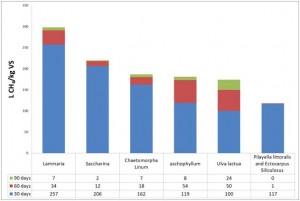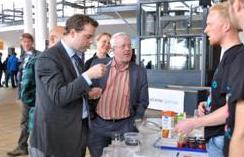 More than 400 different species of macro algae – commonly called seaweed, grow in Danish waters. Seaweed is a resource that can be used use in a number of ways, among others for sustainable energy, pet foods and for a cleaner marine environment. This was the conclusion in the recently completed project “Algae for biogas in Central Denmark Region“, conducted by the partners behind AlgaeCenter Denmark,i.e. Danish Technological Institute, Aarhus University, Ocean Centre Denmark and Kattegatcentre – in collaboration with DONG Energy.
More than 400 different species of macro algae – commonly called seaweed, grow in Danish waters. Seaweed is a resource that can be used use in a number of ways, among others for sustainable energy, pet foods and for a cleaner marine environment. This was the conclusion in the recently completed project “Algae for biogas in Central Denmark Region“, conducted by the partners behind AlgaeCenter Denmark,i.e. Danish Technological Institute, Aarhus University, Ocean Centre Denmark and Kattegatcentre – in collaboration with DONG Energy.
The main objective of the project was to find the best ways to get the highest possible biogas yield from seaweed. In addition, the possibilities of using wastewater and manure as a nutrient source, flue gas as a CO2 source for photosynthesis in seaweed and residue from biogas production as fertilizer in agriculture was also examined.
Cultivation experiments at pilot plant
The project began in 2010 and was supported by approximately €1.34 million from EU’s Seventh Framework Programme (project BioWALK4BioFuels), Central Denmark Region, The Brothers Hartmann’s foundation and the project partners. In 2010 an algae cultivation pilot plant was built in Grenaa by AlgaeCenter Denmark and this was a central location for research, development and dissemination of the project.
The results of the project are unmistakable: seaweed is suitable for biogas production – and for many other purposes. ”We gained extensive new knowledge from the project”, says Annette Bruhn, project manager and researcher from Aarhus University. “First, we documented that there are good opportunities for using seaweed to produce biogas. Secondly, we also found that the residue from biogas production is suitable as fertilizer and that seaweed efficiently absorb nutrients from manure and wastewater and CO2 from flue gas. Therefore, seaweed can be used as a biofilter.”

No pretreatment necessary
Algae’s cell walls contain cellulose as like as land-based plants, but the content is generally lower in algae. Unlike plant biomass, algae cell walls contain no lignin but instead various other carbohydrates, for example alginates in brown algae and ulvan in green algae. The concentration and availability of storage substances, structural carbohydrates and potential inhibitory substances vary between different groups and species of algae and hence the biogas potential is expected to vary as well. The biogas potential of relevant species of Danish algae were studied and the biogas potential for especially Laminaria digitata (oarweed) are very promising (figure right). Most promising is the fact that the results from the project reveal that no pretreatment of the algae is necessary prior to biogas production.
“Work on the project Algae for biogas in Central Denmark Region has resulted in a multitude of activities. We have been in contact with several companies in Denmark, Scandinavia and Europe, all of which are interested in embarking on the development of seaweed. We very much look forward to being able to help these businesses with the knowledge gained among others in this project”“says Lars Nikolaisen, Head of Section of Marine Biomass, Danish Technological Institute.

At the 2013 Festival of Research, Morten Oestergaard, Danish Minister of Science, Innovation and Higher Education visited the Algae Center Denmark in Grenaa. “For me this was a good example of how research has the ability to change things. Research in seaweed is a good example of how research can find sustainable solutions. And it demonstrates that research is a substantial precondition for us to be able to keep our wealth and welfare“.
Jens Legarth, CEO Fermentationexperts says: “It is important to get a Danish seaweed production on an industrial scale. Seaweed is a valuable source of essential amino acids that are in low supply in protein derived from terrestrial plants. We are ready to buy millions of tons of seaweed for the production of optimized feed protein for pigs. But we need a stable supply and quality – and a competitive price“.
With the new knowledge from algae for biogas in Central Denmark Region the hope is that seaweeds will be cultivated in the waters surrounding Denmark and used for feed, food, high value products, fertilizer and sustainable energy. Subsequently, seaweeds could create new jobs throughout Europe. AlgaeCenter Denmark welcomes students and various stakeholders to learn more about algae and their potential applications as well as a tour of the pilot plant.
Read more about the project here.
This post was written by Karin Svane Bech – Danish Technological Institute – Denmark


